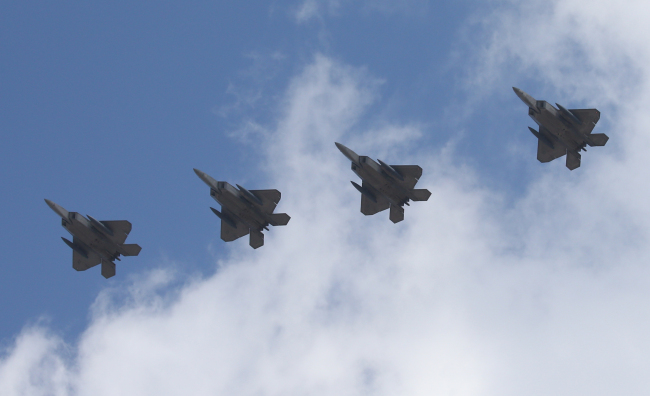The United States on Wednesday flew four of its F-22 stealth fighter jets over South Korean airspace in what is widely interpreted as a demonstration of power and alliance, following Pyongyang’s nuclear and missile provocations and Seoul’s unusually strong words against its hostile neighbor.
The “Raptor” jets arrived at Osan Air Base in Pyeongtaek, Gyeonggi Province around noon, after taking off from Kadena Air Base in Okinawa, Japan, which received the jets last month.
“Two of the jets will stay here for a while, and the other two will report back to (their) base (in Okinawa),” an official from the 7th U.S. Air Force said. He did not specify how long the jets would remain in the country, or if they would take part in the annual South Korea-U.S. joint military drills next month.
The “Raptor” jets arrived at Osan Air Base in Pyeongtaek, Gyeonggi Province around noon, after taking off from Kadena Air Base in Okinawa, Japan, which received the jets last month.
“Two of the jets will stay here for a while, and the other two will report back to (their) base (in Okinawa),” an official from the 7th U.S. Air Force said. He did not specify how long the jets would remain in the country, or if they would take part in the annual South Korea-U.S. joint military drills next month.

Capable of sneaking past radar detectors, the Lockheed Martin-built Raptor jets are known to be able to find, track and target both air and ground-based threats. They can accelerate past Mach 1.5 -- 1 1/2 times the speed of sound -- without afterburners, and can top Mach 2 at maximum capacity.
The F-22 jets were escorted by four U.S. F-15 jets and four South Korean F-15K jets.
“The mission demonstrates the strength of the alliance between the U.S. and the Republic of Korea, and the resolve of both nations to maintain stability on the Korean Peninsula,” said Terrence O’Shaughnessy, the commander of the 7th Air Force. He added that the Raptor jets represents “one of many capabilities available” to defend South Korea.
South Korea’s Air Force Operations commander Lt. Gen. Lee Wang-keun stressed that North Korea's recent missile launch and its fourth nuclear test presented “a very serious security situation.”
“ROK (South Korea) and U.S. combined air forces remain ready to deter North Korean threats and are postured to defeat them firmly with the strength of our combined air combat capability,” he said.
The rift between the Koreas deepened last month upon Pyongyang’s nuclear test and again earlier this month when Pyongyang fired a long-range rocket.
South Korea’s ambassador to the United Nations Oh Joon told local media that it is possible a new U.N. Security Council resolution on North Korea could be adopted as early as next week. Oh said he expects it to carry stronger sanctions than before.
Deploying the cutting-edge jets was the latest move in the U.S. sending its strategic assets to the Korean Peninsula. Last month, Washington deployed the nuclear-capable B-52 bomber to South Korea, four days after Pyongyang conducted a nuclear test.
Washington had also dispatched a nuclear-powered USS North Carolina last week for a three-day joint naval drill with Seoul. USS John C. Stennis -- a Nimitz-class nuclear-powered aircraft carrier -- is expected to take part in the joint military exercises next month, and a B-2 stealth bomber is also predicted to be deployed here.
An anonymous military source said that U.S. may also dispatch Maritime Prepositioning Ship Squadron for the drill, adding that the decision to send high-powered strategic assets was likely to have been made by U.S. policymakers.
MPSRON each comprises between four to six maritime prepositioning force ships, which strategically position supplies for the U.S. Marine Corps at sea. They are laden with equipment and supplies like tanks, ammunition, food, water, fuel, spare parts and hospital gear. Each MPSRON is capable of carrying supplies and equipment needed to sustain more than 16,000 marine and navy personnel for up to 30 days.
With the allies stepping up vigilance, a U.S.-based think tank warned Tuesday of the possibility of Pyongyang conducting its fifth nuclear test.
“Given the recent experience with the Jan. 6 test -- namely that North Korea appears to have altered its past test preparation practices in order to make them more difficult to detect -- it may well be that the North could conduct another detonation with little or no warning,” said the 38 North website, operated by the U.S.-Korea Institute at Johns Hopkins School of Advanced International Studies.
Based on analysis by Jack Liu, the website said that satellite images suggest that the North may already have tunnels completed and ready for the nuclear test.
It said that images are unable to distinguish between the tunnels being partially sealed during maintenance or construction and tunnels being sealed for the test preparation, pointing out limits in predicting nuclear tests.
By Yoon Min-sik (minsikyoon@heraldcorp.com)



![[KH Explains] Hyundai Motor’s plan for new landmark keeps hitting bumps](http://res.heraldm.com/phpwas/restmb_idxmake.php?idx=644&simg=/content/image/2024/05/13/20240513050626_0.jpg&u=20240513192803)
![[Grace Kao] American racism against Stray Kids](http://res.heraldm.com/phpwas/restmb_idxmake.php?idx=644&simg=/content/image/2024/05/13/20240513050827_0.jpg&u=)













